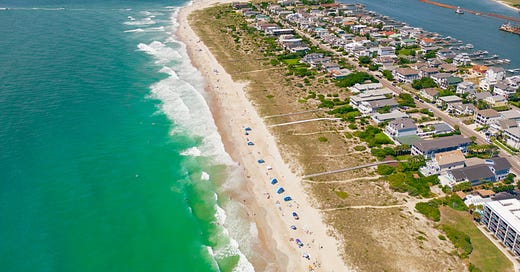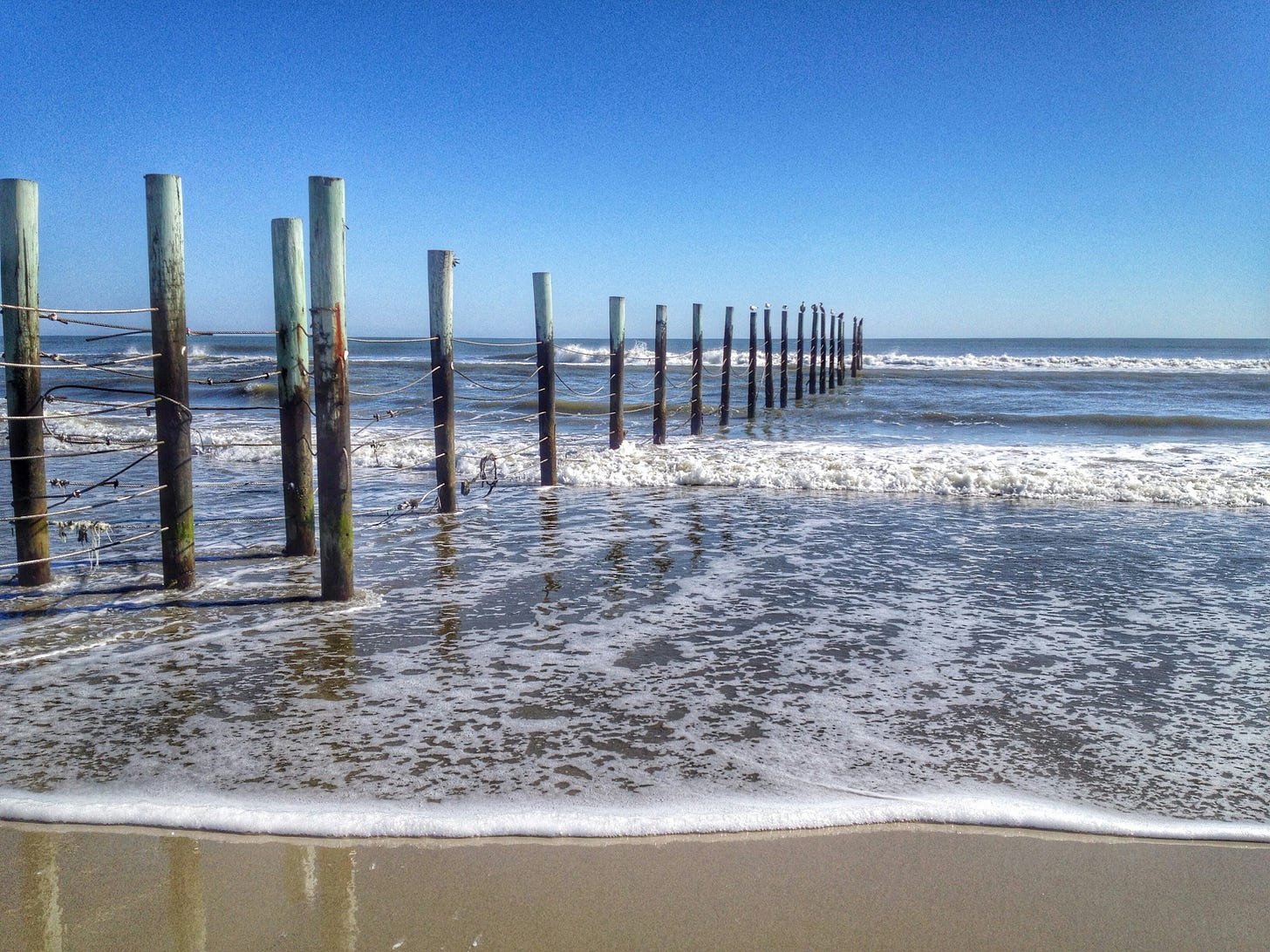New Plan: America’s Barrier Islands
I’m excited to begin Gumption’s first plan! Through this plan, we’ll explore how to preserve America’s vanishing barrier islands.
Gumption plans start by following the problem. This post introduces the problem space, and we’ll continue to unpack the climate problems surrounding America’s barrier islands over the next two months.
Millions of people will travel to the barrier islands of the American East and Gulf coasts this summer, just as they have every year for hundreds of years. Islands like Cape Cod and Miami Beach. With remote, sun-soaked, casual vibes, and some of the most beautiful beaches in the world; it’s easy to see why people are drawn to America’s barrier islands.
I also have a deep love for America’s barrier islands. I grew up hopping between barrier islands along the North Carolina coast. I learned to swim in the bays behind Topsail Island and had my first kiss on the Outer Banks. Now, living in NYC, I find sanctuary and community in the queer beach enclaves of the Rockaways and Fire Island.
But the barrier islands we know and love today—and everything tied to the vitality of these islands—may soon vanish because of climate change.
Islands in Motion
Barrier islands are constantly in motion. The geomorphic forces pushing islands are complex, and scientists disagree on the specifics. But we need to understand the basics to save the islands.
Undeveloped barrier islands move in two ways. First, the islands are constantly moving parallel to the shoreline, with currents carrying sand from one end to the other. This is called longshore drift. Second, when ocean waves wash over the islands’ dunes, typically during a storm or extreme high tides, sand is eroded from the beach dunes and deposited closer to the bay. This is called overwash.
Rising tides from climate change will increase overwash, leading the islands to either be pushed toward the mainland or drowned. An island is pushed back and up as flood waters gradually roll the island on top of itself—from beach to bay, over and over again. The island will remain above water if it doesn’t lose too much sand.
When an island loses too much sand, or when sea level rise is too fast, the island reaches a critical breaking point and drowns. However, it’s rare for an undeveloped barrier island to drown—most natural barrier islands have moved with sea level rise.
In Virginia, barrier islands move landward an average of over 20 feet per year, and the rate of movement is expected to accelerate by up to 50 percent by 2100. The narrowest Atlantic barrier islands are about 650 feet wide; at this rate, the future beachfront would move to today’s bay shoreline in about 30 years, if not sooner.
People vs. Nature
Without human intervention, America’s barrier islands, and the bays and marshes behind them, would naturally move and be reconstructed with sea level rise. But America’s barrier islands are at risk of drowning because we’re trying to hold them in place.
Development on the islands—especially walls designed to hold sand in place—prevent the islands from moving, thereby exposing the islands to catastrophic erosion. Gradually, sea level rise will erode sand and wetlands away from the fortified islands and eventually remove the very foundations on which the walls are built. By the time the island is fully submerged, the bay will be too deep for new barriers to form, exposing the mainland to the ocean.
Property owners especially don’t want their islands to move. If I own a waterfront property and half of the (virtual) boundaries of my property are washed away by a hurricane, rebuilding the shoreline or preventing further erosion would be in my financial interest. These financial interests are so powerful that in 2012 coastal developers in North Carolina felt so threatened they convinced lawmakers to make climate change…illegal.
Beach towns have responded by rebuilding and fortifying. After a hurricane, towns spend millions of dollars to replace their beaches and strengthen island defenses. Decades ago, beach towns may have undertaken these projects every five years. Now, as climate change accelerates, beach towns are considering these major projects every year, if not multiple times a year. Most communities can no longer afford these projects, so they’ve turned to their states and the federal government for permanent financial support. The future of America’s barrier islands is no longer a local problem—it’s a national problem.
I question if our relationship with barrier islands is sustainable. Where should taxpayers continue to subsidize the fortification of barrier islands? Where should we retreat and allow the islands to move on their own? Can we continue occupying America’s barrier islands without holding them in place? These questions inspired me to explore barrier islands for Gumption’s first plan.
Leadership Gaps
Surely this problem is so big, and affects so many people, that there’s already a plan, right? I have good news and bad news. The good news is that governments at every level—local, state, and federal—want to protect America’s barrier islands. The bad news is they’re not doing enough.
Today, America’s barrier islands are guided by a patchwork of federal and state policies. These policies are inconsistent and sometimes compete with each other. Flood insurance is a notable example: federal laws both discourage and incentivize development on barrier islands. There’s a long alphabet soup of federal agencies with jurisdiction over barrier islands (NOAA, FEMA, EPA, USACE). I have tremendous respect for each of these agencies, but they’re not working together to create holistic solutions for America’s barrier islands.
Lately, the real champions of America’s barrier islands have been local governments. Local governments recognize the existential crises facing their islands and they’re doing everything in their power to save themselves. From Miami to Nags Head, local governments are creating forward-looking strategies for their communities with climate resilience at the center. Much of this work is funded through federal and state grants—a lifeline for local communities.
But local governments can only do so much. Their resources are severely constrained, which limits the scale of projects they pursue. And they have little incentive to plan beyond their boundaries. If a local government’s actions save their community but put another community in danger, they don’t have a legal responsibility to care.
As I mentioned in last week’s post, Gumption plans focus on problems without leadership. I’ll dive deeper into the leadership challenges facing America’s barrier islands in future posts. But as I embark on creating this plan, it’s clear that leadership is sorely needed to save America’s barrier islands.
When should local governments decide their future? Or when is it up to states and the federal government? What role should the private sector play? What is an individual’s responsibility? I’ll come back to questions of leadership and responsibility in almost every post.
More on America’s Barrier Islands
Over the next two months, I’ll continue to unpack the problems surrounding America’s vanishing barrier islands. The next four posts will highlight everything we could lose if America’s barrier islands disappear.
Your Turn!
What’s your favorite American barrier island? Share your stories in the comments below or email me at blake@gumption.earth!










